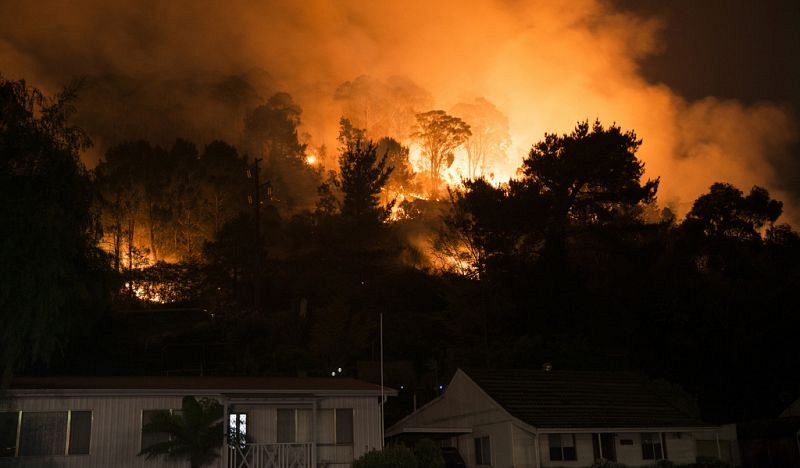Hazard Reduction (HR) enthusiasts like a simple syllogism: that fire has three elements — ignition, fuel, and oxygen.
The only one we can influence is fuel. Therefore, HR burns are the answer.
Unfortunately, it’s not that simple. Human activity can influence much more than the simple fuel trio, and the first variable is context. Is the fire covering a large area or a small area? Is it a long-term problem, or something to be solved in a few days? And what are the assets being threatened?
As a rural firefighter, I have attended many HR burns and survived to tell the tale. Sometimes, an HR burn can be a successful – even elegant – solution to a problem.
On one occasion, the Brigade Captain was sitting in his 4WD on a slight rise, so he could see the whole perimeter of the HR burn. At intervals, there were the trucks from the several brigades taking part, moving slowly behind the drip-torch operators, who were on foot (a drip-torch is like a watering can, and releases a burning mixture of petrol and diesel).
The drip-torches were instructed to light the undergrowth in small spots, each about ten metres apart, inside the bull-dozed earth perimeter. As these small spots of flame grew and joined, the fire became fiercer, and the hose operators, also on foot but attached to a truck, damped down anything which was going too quickly or threatening valuable trees or fences.
The burn proceeded at a slow walking pace, but as more of the perimeter started flaming, the live fire was drawn inwards by the breeze which the fire itself had created. Eventually, all the flank fires came together in a spectacular but quite safe conflagration in the centre of the blackened HR area. Now, all that was needed was careful patrolling for the next few days.
It’s not always that simple. On another day, in steep country, we patrolled around what had been a successful burn the previous day, only to find that the helicopter which had been assisting us had dropped a load of incendiaries on the wrong side of the fire trail, outside the perimeter. Suddenly, the routine patrol became something close to a crisis and more crews were called up on the radio.
Then there were the big multi-agency burns, taking in whole mountain ranges, fleets of helicopters and fire trucks and white 4WD utes containing important people. These are generally the ones where the old army adage is heard: hurry up and wait!
A well-equipped fire truck has a couple of folding chairs, and perhaps a billy, just in case. And, of course, there were all the HR burns which were cancelled or postponed because of a change in the weather forecast or the lack of crews – all volunteers – who might be available.
HR burns and “backburning” are not the same thing. Backburning is used when actually fighting a fire, or preparing to fight a fire, by burning back against the wind, from a feature such as a river or a road towards an oncoming blaze, thus creating a firebreak. It is a difficult and potentially dangerous procedure.
Professor Kevin Tolhurst of Melbourne University is a recognised expert on fire behaviour and is in much demand as a speaker and commentator. In his view, HR burns are the only logical response to a worsening situation.
In a recent article for The Conversation, he looks at both sides of the question and concludes that there is a place and a time when HR burning is very effective.
He particularly takes issue with a January 2020 paper from the Climate Council, saying:
'[We] need to use good scientific evidence, but our decisions must be based on the whole picture, not just a selective part of it.'
HR burns are seldom an unalloyed good: a “successful” burn may be followed by an enthusiastic invasion of African grasses, blackberries, or other weeds. It is also difficult to imagine how modern fire managers could hope to reproduce Aboriginal fire practices, in an Australia which is crisscrossed by roads, property boundaries and fences.
The science is, of course, open to argument. Science is never “settled”, but there is an overwhelming consensus that climate change is real, is affecting today’s bushfires and will continue doing so in the future.
Few people would disagree that HR burns are an essential tool and need to be carried out as a matter of routine. However, no objective observer would claim that HR burns are the single solution and use this as reason to dismiss the importance of climate change.
It’s a strange case of not seeing the wood for the burning trees.
Nick Goldie is a science journalist and volunteer firefighter who lives in rural NSW. He is currently writing a book on extreme fire events with fellow volunteer firefighter, mathematician and Professor Jason Sharples and A.C.T. Emergency Services researcher Rick McRae.
 This work is licensed under a Creative Commons Attribution-NonCommercial-NoDerivs 3.0 Australia License
This work is licensed under a Creative Commons Attribution-NonCommercial-NoDerivs 3.0 Australia License
Support independent journalism Subscribe to IA.












